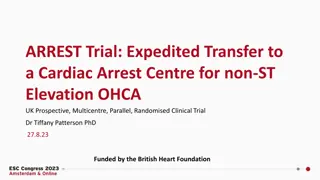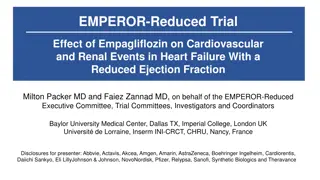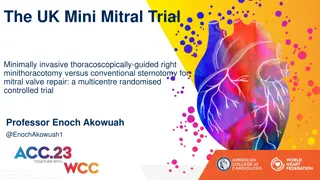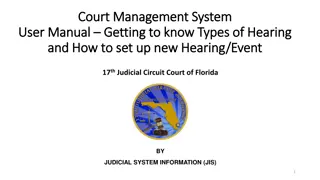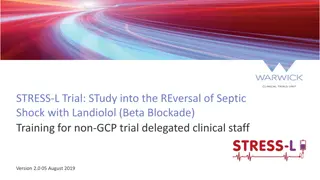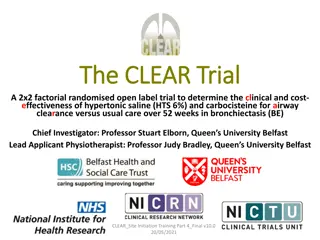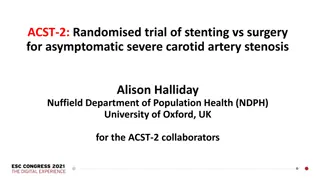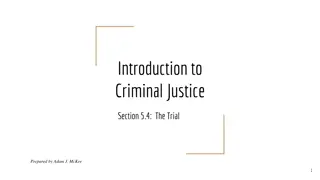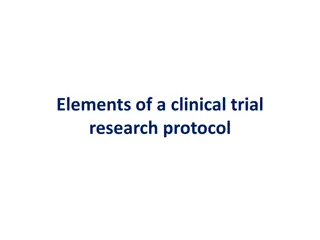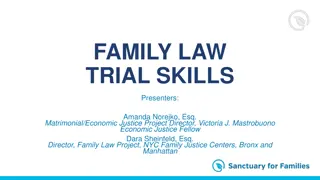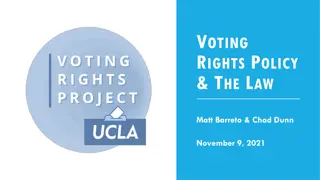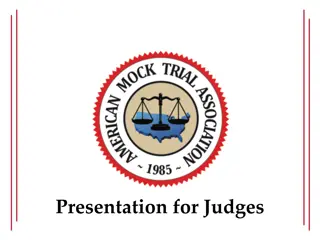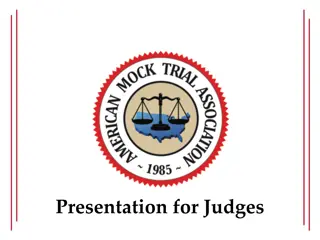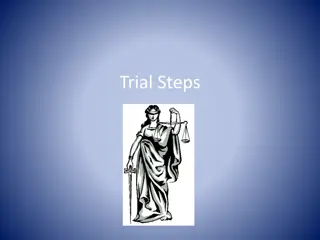Trial Strategies and Techniques: Top 10 Insights
Explore the top 10 trial traps, tricks, and techniques presented by Judge Joyce Draganchuk from Ingham County Circuit Court. Learn about self-representation requirements, managing disruptive defendants, challenges in jury selection, and more essential insights for a successful trial practice.
Download Presentation

Please find below an Image/Link to download the presentation.
The content on the website is provided AS IS for your information and personal use only. It may not be sold, licensed, or shared on other websites without obtaining consent from the author. Download presentation by click this link. If you encounter any issues during the download, it is possible that the publisher has removed the file from their server.
E N D
Presentation Transcript
TOP 10 TRIAL TRAPS, TRICKS, AND TECHNIQUES
Presented by: Presented by: Judge Joyce Draganchuk Ingham County Circuit Court
TTT #1 Your client wants to fire you
Self-representation requirements People v Williams, 470 Mich 634 (2004) 1. Defendant s request must be unequivocal 2. The Court must determine that it is knowing, intelligent, and voluntary 3. It must not disrupt, inconvenience, or burden the Court 4. The Court must comply with MCR 6.005(D) by advising defendant of (a) the charge (b) the max/min sentence (c) the risks (d) advisory counsel
Disruptive defendant who is self- represented Where the defendant is disruptive (or seemingly manipulative), representation may be denied based on your finding that it would inconvenience and burden on the court. People v Ahumada, 222 Mich App 612 (1997) the self- be an undue
Self-representation requirements Judge must re-affirm at each proceeding
Defendant wants new court-appointed attorney Substitution = good cause + will not unreasonably disrupt the judicial process Good cause = legitimate difference of opinion develops with regard to a fundamental trial tactic
TTT #2 This jury looks nothing like my client
Distinguish 2 different challenges 1. Batson challenge: People v Knight, 473 Mich 324 (2005) (a) applies to the use of peremptory challenges on individual jurors (b) must be made before jury is sworn (c) remedy is to start over 2. Challenge to the venire (a) based on the 6thAmendment: right to an impartial jury drawn from a fair cross section of the community (b) bigger issue than just one trial
Batson challenge 1. Defendant must show a prima facie case of discrimination (a) he/she is a member of a cognizable group (b) the proponent has exercised a peremptory challenge to exclude a member of a certain racial group from the jury pool (c) all the relevant circumstances raise an inference that the proponent of the challenge excluded the prospective juror on the basis of race
Batson challenge 2. The defendant s prima facie case with a race-neutral reason for dismissing the juror(s) it need not be persuasive or even plausible just facially valid prosecutor may rebut the
Batson challenge 3. The trial court must determine whether the explanation is discrimination. This is a credibility issue for the trial court. prosecutor s pretext a for
Challenge to the venire (1)The group alleged to be excluded must be a distinctive group in the community; (2) The representation of this group in venires from which juries are selected is not fair and reasonable in relation to the number of such persons in the community; and (3) The underrepresentation systematic exclusion of the group in the jury-selection process. is due to
TTT #3 Defendant does not like his outfit
The defendant is denied due process where his clothing impairs the presumption of innocence Defendant waives when he voluntarily chooses to stand trial in jail clothing Make a record that clothes are available Judge does not have to warn him of prejudice
The defendant is denied due process where his clothing impairs the presumption of innocence A timely request to be dressed in civilian clothes must be granted. People v Lee, 133 Mich App 299 (1984) Where the trial court observes defendant s clothing and finds it does not look like prison garb, the appellate court will defer to the trial court and only review for an abuse of discretion. People v Harris, 201 Mich App 147 (1993)
Examples of trial court findings that were upheld Blue pants and shirt look like what young people wear now and differs from prisoner s clothes. People v Harris, 201 Mich App 147 (1993) Defendant s clothes resemble work clothes. People v Woods, 32 Mich App 358 (1971) A white t-shirt. People v Ealy (unpub 6-19-12)
TTT #4 The prosecutor has not turned over evidence
Discovery violations Is it about a witness or a tangible object that the pros. is using at trial? [see list MCR 6.201(A)] OR Is it exculpatory evidence; a police report; defendant, co-def or accomplice statement; search warrant; agreement testimony? [MCR 6.201(B)] OR Is it something that was ordered for good cause shown? [MCR 6.201(I)] IF NO TO ALL no discovery violation IF YES TO ANY discovery violation for
Discovery violations Did knowledge? transcribed into report or def s own statement) YES No prejudice No remedy def. have (e.g. actual notes NO disclosure prejudice? Does cause the late actual If proceed to remedy actual prejudice,
Discovery violations Remedy (balancing interests of courts, public, and parties including reason for non-compliance): 1. Order to provide 2. Permit inspection 3. Continuance 4. Allow evidence of non-production 5. Jury instruction 6. Exclude (most egregious case) 7. Mistrial (if it impairs a fair trial) 8. Dismissal --flagrant --wanton --conscious --intentional
TTT #5 Defendant is disruptive/assaultive
Disruptive defendant 1. Right to be present 2. Warnings 3. Chances to reform/return
Options Remove him from courtroom and use video. Gag him. People v Kerridge, 20 Mich App 184 (1970), reversed on other grounds in People v Parker, 393 Mich 531 (1975), cited with approval in People v Conley, 270 Mich App 301 (2006)
Procedure Allow defendant to see and hear Break after direct to allow counsel to consult before cross Have counsel ask defendant at each consultation whether he want to return to the courtroom
TTT #6 Witness violates sequestration order
WHAT was ordered? there is no sequestration order unless the judge actually ordered it if you ask that witnesses not be in the courtroom, you should also ask that they not discuss their testimony if there is no order not to discuss testimony, then there is no violation when they do
WHY was the order violated? Was it on purpose or accidental?
WHO violated the order Crime victim? Crime Victim s Rights Act allows victim to remain in the courtroom after 1sttestifying (but compare Const. 1963, art 1, 24 allowing victim to attend trial and all proceedings defendant has the right to attend)
WHO violated the order? Prosecution witness? Consider the purpose behind sequestration did the witness hear things that pertained to that witness s testimony? MRE 615: the court may order witnesses excluded so that they cannot hear the testimony of other witnesses
WHO violated the order? Defense witness? Consider the purpose behind sequestration and whether it would deprive the defendant of a defense if the witness is precluded from testifying
DISCRETION OF COURT Choose the appropriate remedy: 1. Nothing 2. Contempt 3. Permit cross-exam on the violation 4. Preclude witness from testifying
TTT #7 Witness fails to appear
Prosecutor requests adjournment MCR 2.503(B)(1) Subpoenaed witness due diligence is shown by service of the subpoena and it is an abuse of discretion to deny adjournment and dismiss case. People v Jackson, 467 Mich 272 (2002) Unsubpoenaed witness due diligence hearing and due diligence finding required for adjournment
Prosecutor requests to use P/E testimony MRE 804(a)(5) and 804(b)(1) 1. The witness is absent from the hearing, and 2. Due diligence is shown
Witness FTA after trial started Bench warrant (if subpoenaed) Contempt Use as a tool to get witness there during trial Usually prosecution uses this MCL 767.40a
TTT #8 Defendant fails to appear after jury sworn
Defendant may waive right to be present by voluntary absence A defendant's voluntary absence from the courtroom after trial has begun waives his right to be present and does not preclude the trial judge from proceeding with the trial to conclusion. People v Swan, 394 Mich 451 (1975)
Judge Kennys checklist The local county jail and adjoining county jails Two major hospitals in the area County morgue Post Office Residence and employment address School system if witness or defendant has school age children
TTT #9 Witness takes the 5th
The Rule A lawyer may not call a witness who is intimately related to the criminal episode at issue when it is known that the witness will assert the Fifth Amendment against self-incrimination. Giacalone, 399 Mich 642 (1977). privilege People v
Procedure where it is known witness may assert the 5th People v. Poma, 96 Mich App 726 (1980); People v Dyer, 425 Mich 572 (1986) 1. Proceed outside the presence of the jury 2. Appoint counsel 3. Hold hearing where first it is established that the witness understands the privilege (because either counsel has advised or the judge explains)
Procedure where it is known witness may assert the 5th People v. Poma, 96 Mich App 726 (1980); People v Dyer, 425 Mich 572 (1986) 4. Have the proponent ask the intended questions 5. If the witness asserts the 5thto any questions, verify that the witness intends to do so if called before the jury 6. The judge, not the witness, determines whether the assertion of the privilege is valid or not (based on a reasonable belief)
Procedure where it is known witness may assert the 5th People v. Poma, 96 Mich App 726 (1980); People v Dyer, 425 Mich 572 (1986) 7. If the judge determines that the privilege being asserted is not valid, the judge may proceed with contempt finding 8. If witness persists in taking the 5th, whether a valid assertion or not, the witness may not be called to the stand
Procedure when it is not known in advance that the witness will assert the 5th There is none! Follow People v Poma and People v Dyer Give jury instruction if requested
TTT #10 The judge and/or prosecutor is out of line
Judicial Intervention Control the courtroom and interrogation of witnesses under MRE 611 Pierce the veil of judicial impartiality Deny fair trial
Examples of what is acceptable Make evidentiary rulings. People v Jackson, 292 Mich App 583 (2011) Comment on the evidence to the extent that it explains a ruling. People v Walker (unpub COA, 3-31-16) Interrupt attorney or witness who is about to state something irrelevant or inadmissible. People v Ullah, 216 Mich App 669 (1996); People v Grimmett, 27 Mich App 509 (1970) Raise the issue of defendant s competency to stand trial where there is a bona fide doubt about his competency. People v Groeneveld, 54 Mich App 424 (1974)
Examples of what is acceptable Intervene when a witness is subject to harassment or undue embarrassment. MRE 611(a) Admonish an attorney who deserves it (but best done outside presence of jury). People v Daniel, supra Ask witnesses questions aimed at clarification or to produce fuller and more exact testimony or elicit additional relevant information. MRE 614(b); People v Stevens, 498 Mich 162 (2015) Inform the jury that a fact is established if the defendant admits its occurrence. People v Hamer, 19 Mich App 318 (1969) ( a man died )
Examples of what is acceptable Propose giving an instruction that is applicable even when it has not been requested. Propose giving a lesser-included offense instruction even when it has not been requested. People v Till, 115 Mich App 788 (1982)





